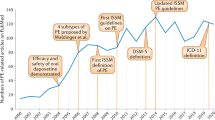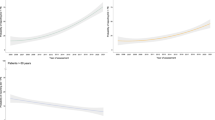Abstract
Premature ejaculation (PE) has been reported in 40.6–51.5% of men affected by Parkinson’s disease (PD), however, this non-motor sexual complaint has not been studied in detail. We describe eight PD patients who asked for a sexological consultation between 2008 and 2014 because of a new-onset of PE. They were diagnosed with acquired PE (APE) according to the DSM-V criteria and the International Society for Sexual Medicine (ISSM) committee. Patients’ demographic, medical and sexual related data were retrieved and studied. The average age of onset of PD was 53.3 ± 12.7 years (range 38–77 years) and the sexual problem appeared 4.0 ± 3.1 years later. The mean intravaginal ejaculation latency (IELT) before APE onset was 7.3 (range 2–20) min. Interestingly, the ejaculatory disorder appeared abruptly, characterized by a dramatically shortened IELT in all patients, while in three of the cases ejaculation occurred before vaginal penetration, hampering sexual intercourse. Some patients had 2 additional sexual problems, (four with erectile dysfunctions, five with libido changes: increased desire in four and reduced in one). In this case series of PD patients with APE, the ejaculatory dysfunction developed when patients were on antiparkinsonian medications, suggesting a possible medication effect.
This is a preview of subscription content, access via your institution
Access options
Subscribe to this journal
Receive 8 print issues and online access
$259.00 per year
only $32.38 per issue
Buy this article
- Purchase on Springer Link
- Instant access to full article PDF
Prices may be subject to local taxes which are calculated during checkout
Similar content being viewed by others
References
Porst H, Montorsi F, Rosen RC, Gaynor L, Grupe S, Alexander J. The premature ejaculation prevalence and attitudes (PEPA) survey: prevalence, comorbidities, and professional help-seeking. Eur Urol. 2007;51:816–23.
Graziottin A, Althof S. What does premature ejaculation mean to the man, the woman, and the couple? J Sex Med. 2011;8:304–9.
Serefoglu EC, McMahon CG, Waldinger MD, Althof SE, Shindel A, Adaikan G, et al. An evidence-based unified definition of lifelong and acquired premature ejaculation: report of the second International Society for Sexual Medicine Ad Hoc Committee for the Definition of Premature Ejaculation. J Sex Med. 2014;11:1423–41.
American Psychiatric Association. Diagnostic and statistical manual of mental disorders, 5th ed. Washington DC, 2013.
Waldinger MD, Schweitzer DH. Changing paradigms from a historical DSM-III and DSM-IV view toward an evidence-based definition of premature ejaculation. Part II--proposals for DSM-V and ICD-11. J Sex Med. 2006;3:693–705.
Bronner G, Kitrey ND, Uziel N, Eli I, Raviv G, Ramon J, et al. Correlation between premature ejaculation and female vaginal penetration difficulties. Int J Impot Res. 2015;27:152–6.
Waldinger MD, Quinn P, Dilleen M, Mundayat R, Schweitzer DH, Boolell M. A multinational population survey of intravaginal ejaculation latency time. Sex Med. 2005;2:492–7.
Waldinger MD, Hengeveld MW, Zwinderman AH, Olivier B. An empirical operationalization study of DSM-IV diagnostic criteria for premature ejaculation. Int J Psychiatry Clin Pract. 1998;2:287–93.
Serefoglu EC, Yaman O, Cayan S, Asci R, Orhan I, Usta MF, et al. The comparison of premature ejaculation assessment questionnaires and their sensitivity for the four premature ejaculation syndromes: results from the Turkish society of andrology sexual health survey. J Sex Med. 2011;8:540–8.
Gao J, Peng D, Zhang X, Hao Z, Zhou J, Fan S, et al. Prevalence and associated factors of premature ejaculation in the Anhui male population in China: evidence-based unified definition of lifelong and acquired premature ejaculation. Sex Med. 2017;5:e37–e43.
Gao J, Zhang X, Su P, Liu J, Xia L, Yang J, et al. Prevalence and factors associated with the complaint of premature ejaculation and the fourpremature ejaculation syndromes: a large observational study in China. J Sex Med. 2013;10:1874–81.
Serefoglu EC, Cimen HI, Atmaca AF, Balbay MD. The distribution of patients who seek treatment for the complaint of ejaculating prematurely according to the four premature ejaculation syndromes. J Sex Med. 2010;7:810–5.
Kotková P, Weiss P. Psychiatric factors related to sexual functioning in patients with Parkinson’s disease. Clin Neurol Neurosurg. 2013;115:419–24.
Bronner G, Royter V, Korczyn AD, Giladi N. Sexual dysfunction in Parkinson’s disease. J Sex Marital Ther. 2004;30:95–105.
Sakakibara R, Shinotoh H, Uchiyama T, Sakuma M, Kashiwado M, Yoshiyama M, et al. Questionnaire-based assessment of pelvic organ dysfunction in Parkinson’s disease. Auton Neurosci. 2001;17:76–85.
Jitkritsadakul O, Jagota P, Bhidayasiri R. Postural instability, the absence of sexual intercourse in the past month, and loss of libido are predictors of sexual dysfunction in Parkinson’s disease. Park Relat Disord. 2015;21:61–67.
Hughes AJ, Daniel SE, Kilford L, Lees AJ. Accuracy of clinical diagnosis of idiopathic Parkinson’s disease: a clinico-pathological study of 100 cases. J Neurol Neurosurg Psychiatry. 1992;55:181–4.
Bronner G, Royter V, Korczyn AD, Giladi N. Sexual dysfunction in Parkinson’s disease. J Sex Marital Ther. 2004;30:95–105.
Kulisevsky J, Tolosa E. Amantadme in Parkinson’s disease. In: Koller WC, Paulson GW, editors. Therapy of Parkinson’s disease. New York, Marcel Dekker, 1990; p. 143–60.
Olanow CW, Mytilineou C, Tatton W. Current status of selegiline as a neuroprotective agent in Parkinson’s disease. Mov Disord. 1998;13:55–58.
Koller WC, Vetere-Overfield B, Williamson A, Busenbark K, Nash J, Parrish D. Sexual dysfunction in Parkinson’s disease. Clin Neuropharmacol. 1990;13:461–3.
Revicki D, Howard K, Hanlon J, Mannix S, Greene A. Characterizing the burden of premature ejaculation from a patient and partner perspective: a multi-country qualitative analysis. Health Qual Life Outcomes. 2008;12:6–33.
Jacobs H, Vieregge A, Vieregge P. Sexuality in young patients with Parkinson’s disease: a population based comparison with healthy controls. J Neurol Neurosurg Psychiatry. 2000;69:550–2.
Bronner G, Cohen OS, Yahalom G, Kozlova E, Orlev Y, Molshatzki N, et al. Correlates of quality of sexual life in male and female patients with Parkinson disease and their partners. Park Relat Disord. 2014;20:1085–8.
Saitz TR, Serefoglu EC. Advances in understanding and treating premature ejaculation. Nat Rev Urol. 2015;12:629–40.
Kam SC, Han DH, Lee SW. The diagnostic value of the premature ejaculation diagnostic tool and its association with intravaginal ejaculatory latency time. J Sex Med. 2011;8:865–71.
Author information
Authors and Affiliations
Corresponding author
Ethics declarations
Conflict of interest
The authors declare that they have no conflict of interest.
Rights and permissions
About this article
Cite this article
Bronner, G., Israeli-Korn, S., Hassin-Baer, S. et al. Acquired premature ejaculation in Parkinson’s disease and possible mechanisms. Int J Impot Res 30, 153–157 (2018). https://doi.org/10.1038/s41443-018-0034-6
Received:
Revised:
Accepted:
Published:
Issue Date:
DOI: https://doi.org/10.1038/s41443-018-0034-6



